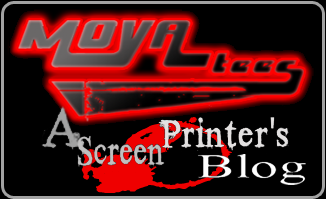To coincide with the development of our new logo and the addition of our brand-spankin’-new conveyor dryer, we wanted to pick up some new products with which to experiment. As I’ve mentioned before, we believe it is important for screen printers to challenge themselves – to learn new techniques and styles.
In the spirit of self-challenging, we ordered some discharge ink earlier this month. Although we had the opportunity to print with discharge at Ryonet’s Los Angeles location, we have yet to utilize it in our own shop. The addition of Gilligan (our new Little Buddy conveyor dryer) seemed like a great time to step up to a new and exciting challenge. We are currently making preparations for our first run of discharge prints next week.
We also picked up some Ryonet WBP Hybrid Emulsion for Water Based & Plastisol. When we first started printing we used CCI DXP (Pink) Diazo-Photopolymer Dual Cure Direct Emulsion, which works very well. However, its primary function is for plastisol ink and breaks down too quickly when used with water-based inks. When we began using the water-based ink we switched to SWR-3 water-resistant emulsion. This also worked well, but is no longer available through Ryonet. Good thing, too. Otherwise we probably wouldn’t have tried the WBP Hybrid emulsion which, as the title of this post suggests, is the best emulsion ever. At least of the three we’ve used.
WBP has a vibrant red color that is helpful during the washout, printing, and cleanup stages. It coats the screen beautifully, dries quickly, and washes out like a dream. The website claims that WBP is easier to use AND reclaim than SWR-3. That’s an understatement! This stuff is amazing, and I highly recommend that every printer at least tries a quart. Also, the cost ($27.99 for a quart) is the same as the cost of standard DXP emulsion. Can’t beat that.
Here are a few quick shots of an exposed screen, coated with WBP.






















